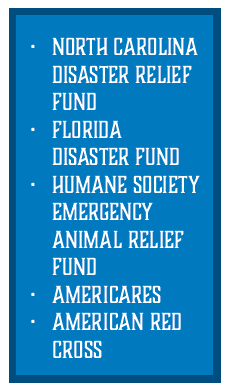
By: Jordan Sarver-Bontrager
Media Writer
Between Sept. 24 and Oct. 9, the southern U.S. was battered with two destructive hurricanes, Helene and Milton. Helene was a category 4 storm and left a tear of devastation on the region that left at least 250 people dead. It is the deadliest hurricane to impact the United States since Katrina in 2005.
The damage from Helene cannot be understated, and it extends beyond the force of nature. The hurricane has spawned multiple conspiracy theories about how the Democratic Party is controlling the weather in these regions for electoral purposes. There are also armed civilian militias in North Carolina, where the hurricane hit hardest, interrupting FEMA operations.
In North Carolina – a state not typically affected by tropical storms to this degree – most residents lacked the insurance necessary to protect them in the event of a disaster like Helene. Many have truly lost everything.
Two weeks ago, Florida was impacted by Milton, a storm that was category 5 at its most powerful in the Atlantic. Milton made landfall in Key Siesta, Florida as a category 3, but still produced flooding and very large, stunning tornadoes similar to ones you’d see in Oklahoma during the spring and summer. The storm has left at least 24 people dead.
Many are left with questions: are storms getting more powerful? Why?
The answer is undoubtedly climate change making the waters more susceptible to producing these monstrosities. In order for a hurricane to begin forming, ocean temperatures need to be around 80 degrees Fahrenheit or 27 degrees Celsius. This makes conditions just right (or wrong) for a tropical depression to form, which can intensify into a tropical storm and then a hurricane.
With Earth’s global temperature rising, these storms are becoming more devastating. Milton was so powerful that it was nearing the mathematical limit of the water and energy that Earth’s atmosphere can produce, with online speculation that it could “break the scale” of hurricane measurement. Thankfully, it didn’t make landfall at that almost incomprehensible strength.
In 2017, Puerto Rico and the surrounding area was devastated by Maria, a powerful category 5 hurricane. This storm opened up discussion on climate change and the role of humans in accelerating warming.
Currently, Earth is on track to warm from 1.1 to 1.8 degrees Celsius. This may not seem like much, but such a shift will cause drastic ecological changes, including atmospheric instability, powerful natural disasters, rising sea levels and threats to biodiversity and crop growth. You may hear on the news at the end of each summer that “this summer has been the hottest on record”, a trend that will continue.
How can we prevent this? Unfortunately, that was a question that should have been taken seriously 10 or 20 years ago – now, there is nothing we can do but try to slow it down. Although individual “green” and sustainable choices are important, large industries are the greatest contributors to anthropogenic climate change. Fossil fuel, the most common source of energy, produces greenhouse gasses that destroy the ozone layer.
Another cause is war. Israel’s constant bombing of Palestine has caused an environmental disaster in the region, with hundreds of thousands of tons of CO2 released in the first 60 days of the war alone. These emissions come from operating military vehicles and producing and using artillery and bombs.
Things are bleak. But, while saving the planet feels like an impossible goal, you can help the people and animals who have been affected by Hurricanes Helene and Milton. The charities below are working to provide clean water, medical aid, emergency shelter and supplies to those affected by the storms. Cash donations are most beneficial.